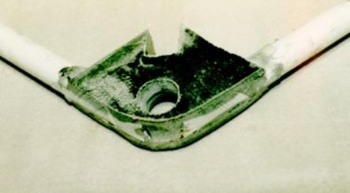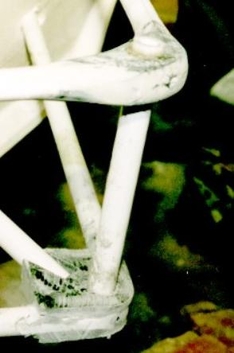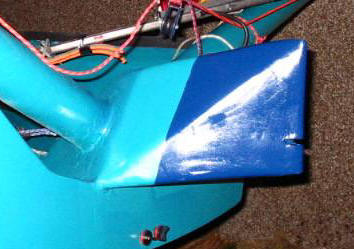Building a Rudder Gantry
These are by no means essential. They help keep the back of the boat clear and aid steering on a two sail reach. On the other hand the loads are tremendous and a failure is a guaranteed race loser. A rudder gantry isn’t that difficult an item to build, so here are a few pointers.
Materials
Successful gantries have been made out of:-
- 18mm diameter pultruded glass tube
- Ordinary 1/2inch wood merchants dowel, reinforced with carbon or glass.
- One inch balsa dowel core coated with carbon and glass
- Aluminium tube
- Titanium!
- Foam Sandwich
The trouble is that unsuccessful gantries have been made out of just about all these materials too. The secret of a good gantry is the joining of all the components. The individual beams rarely fail, it’s usually a join or the attachment to the boat. If you stick some bits of wood dowel together and bodge it with a bit of epoxy filler it’s unlikely to stay together. Similarly if you attach a gantry - which creates considerable and variable tensile loads - straight to the outside skin of a foam sandwich transom the transom will delaminate and the outer skin will be pulled off. Aluminium - let alone Titanium - fabrication is a rather specialised area, and best left to those with appropriate experience. Aluminium gantries assembled from pieces bolted together tend to fail, and an all welded construction is recommended. Without specialist facilities and experience you will be better off using composite construction.
The Bars
 A typical gantry looks something like this. It consists of two V shaped assemblies top and bottom to take the loads, plus a further tube running diagonally upwards from the centre of the lower assembly to the transom to brace the structure further. Depending on exactly how your boat is engineered it may make more sense to have this brace running from the top downwards. Ready made pultruded tube has got to be the easiest material for the bars. Glass seems quite strong enough, but you can use carbon if you want to. If you feel like it and can reliably make good solid tubes then you could make some and use those for the structure, but purchasing the ready made stuff is not too expensive.
A typical gantry looks something like this. It consists of two V shaped assemblies top and bottom to take the loads, plus a further tube running diagonally upwards from the centre of the lower assembly to the transom to brace the structure further. Depending on exactly how your boat is engineered it may make more sense to have this brace running from the top downwards. Ready made pultruded tube has got to be the easiest material for the bars. Glass seems quite strong enough, but you can use carbon if you want to. If you feel like it and can reliably make good solid tubes then you could make some and use those for the structure, but purchasing the ready made stuff is not too expensive.
Assembly

 This is where the project will go right or wrong! I like to make up carbon brackets to join the components. I started by making up two V shaped assemblies for the top and bottom. The join was made by making two triangular carbon/glass plates, about 3mm thick, and gluing them each side of the horizontal tubes with plenty of strong (with microfibres) filler. When this was cured I drilled and cut it for the next join. The vertical piece (that the pin slides through) was glued into the holes drilled in each bracket, and then the diagonal brace in the slot cut in its bracket. At this stage the joins look something like this.
Fill and smooth all the edges, fillet all the angles, and make all the corners nice and blunt. An angle grinder is quick and dangerous, a file slow and safe and essential in the trickier places. Now wrap every join with generous quantities of unidirectional carbon, and perhaps a layer of cloth over the top to keep all neat. Extend the carbon wrapping an appreciable way - maybe an inch - beyond the solid webs, and make sure that it tapers off neatly and smoothly to avoid “hard spots”. The webbing of the joints with the plates, plus the tapered carbon wrapping, is what gives the construction its strength, so fiddle though it is, don’t skimp this hassley job. The vertical tube can have nylon bushes top and bottom for the pin to save wear. If you have no other source buy RS400 ones!
This is where the project will go right or wrong! I like to make up carbon brackets to join the components. I started by making up two V shaped assemblies for the top and bottom. The join was made by making two triangular carbon/glass plates, about 3mm thick, and gluing them each side of the horizontal tubes with plenty of strong (with microfibres) filler. When this was cured I drilled and cut it for the next join. The vertical piece (that the pin slides through) was glued into the holes drilled in each bracket, and then the diagonal brace in the slot cut in its bracket. At this stage the joins look something like this.
Fill and smooth all the edges, fillet all the angles, and make all the corners nice and blunt. An angle grinder is quick and dangerous, a file slow and safe and essential in the trickier places. Now wrap every join with generous quantities of unidirectional carbon, and perhaps a layer of cloth over the top to keep all neat. Extend the carbon wrapping an appreciable way - maybe an inch - beyond the solid webs, and make sure that it tapers off neatly and smoothly to avoid “hard spots”. The webbing of the joints with the plates, plus the tapered carbon wrapping, is what gives the construction its strength, so fiddle though it is, don’t skimp this hassley job. The vertical tube can have nylon bushes top and bottom for the pin to save wear. If you have no other source buy RS400 ones!
Attaching to the boat.
Also vital. A solid stiff rudder and gantry assembly floating a few feet behind the boat has no effect on the steering! There is no substitute for having really stiff and solid mounting points built into the boat. Take the bars of the gantry right through the foam transom and glue them in with a nice strong filled mix. Cut them off flush with the inner edge, radiusing the corners. Cut some strips of unidirectional carbon about 4-6 inches long., “fray” one end, but leave the other end untouched. Wrap it into “sausages” and wet it out thoroughly with epoxy. You want to aim for enough strips that the sausages can only just be crammed into the end of the tube. Feed the good end into the bar for two or three inches, together with enough filler so that it is really thoroughly sticking to the inside of the tube. You’ll need to use a small stick or something, but really get it in there. Now spread the “frayed” end, about another 3 inches, all over the adjacent inner skin, so that it fans out in every direction. In this way the loads from the gantry come right through the transom and are well spread out over the skin, avoiding the risk of delamination of the transom. On wood boats the bars should come right through the transom beams and be well epoxied and filleted in.
Solid Gantrys
 An alternitave to the tubular gantry is to build one out of sheets of foam sandwich, this has a number of advantages. At the end of a build you are likely to have enough off cuts of foam to be able to construct the gantry and the construction is no different from the rest of the boat. Another advantage is that it can be attached to the rest of the boat over a larger area reducing the point loading and the delamination problems that sometimes occur with tubular gantrys.
An alternitave to the tubular gantry is to build one out of sheets of foam sandwich, this has a number of advantages. At the end of a build you are likely to have enough off cuts of foam to be able to construct the gantry and the construction is no different from the rest of the boat. Another advantage is that it can be attached to the rest of the boat over a larger area reducing the point loading and the delamination problems that sometimes occur with tubular gantrys.
Fittings
A lot of problems with composite gantries and rudder stocks come when aluminium or stainless steel fittings are attached. It is virtually impossible to get a reliable bond between metal and composites. If you must use metal fittings then bolt them on solidly to ply pads - nothing else will do. Much better is to fabricate the fittings from epoxy/glass. A pintle will rotate just as happily in a glass tube as in a metal one, and you will find it a great deal easier to integrate the glass tube with the rest of the structure. No doubt it would be possible to create carbon pins for the male part of the fitting, but I prefer to have female fittings on both stock and gantry and run a single stainless steel pin right through the lot.